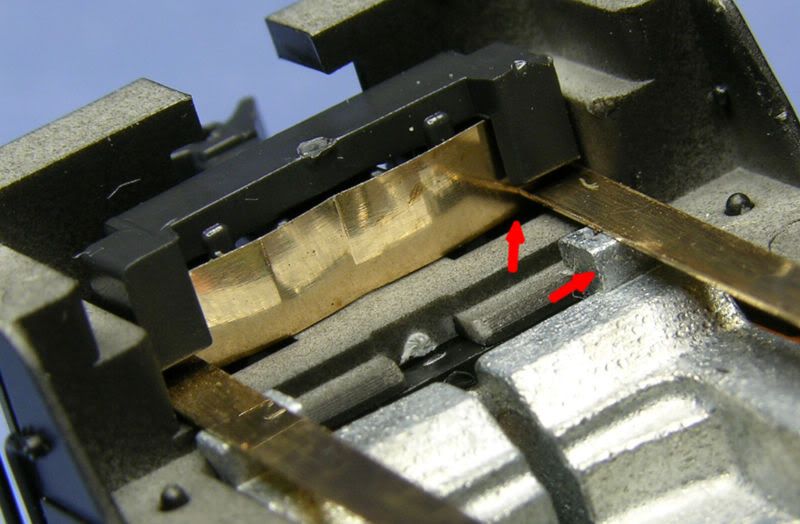Roger,
this problem you described kept bothering me so I decided to figure out what could have caused the short.
This locomotive is one of the ones Kato designed with a "flexible suspension" trucks. The truck's electric pickup strips are not just for picking up the power. They are also used as (single leaf

) leaf springs for softly springing the loco's body/frame on the trucks. Because of that, they are much longer than the usual pickup strips. They also have 2 rest points on each side so they can act like leaf springs. One rest point is at the fuel tank and the other is on the end of the frame. Here is a photo of a properly installed pickup strip/spring (with the truck removed).

As the above photo shows, there is no way for any electric shorts to occur here. The pickup strip rests securely against the raised area on the end of the frame (at the large red arrow) and (as shown by the thin red arrow) there is plenty of plastic between any electrified metal chassis part and the coupler spring
The only way a short could occur is for the pickup strips to be moved towards the end of the loco until they jam against the coupler spring strip. This is how that would look like. The red arrow poiting up vertically shows where the pickup strip is shorting against the coupler spring strip.

This scenario is not something that could have happen by itself. As shown in the first photo, the pickup strips normally rest against the raised areas at the end of the frame. If a truck is installed, it puts even more pressure on the pickup strip so it will not move past that raised area. In order for the strips to be installed incorrectly, they had to be put in after the body was installed over the frame and the fuel tank would have to not been in place.
You say that replacing the coupler fixed the problem. Sure, it fixed the electric short but your engine is probably still not properly assembled. Because if the pickup strips are pushed too far on one end, they are that much shorter on the other end. Here the green arrow shows properly installed pickup strip (it will look the same on both ends of the loco). The red arrow shows a pickup strip with has been pushed too far on the other end of the loco. Instead of resting on the raised area of the frame, the end of the pickup strip floats freely. Because of that, when a truck is installed, it will basically bottom out on the frame instead of sitting on the springy pickup strip. That truck will be riding too low and it will not have a sprung suspension.

You might want to check your SW2 to see if this is the case. If it is, you might want to adjust the pickup strips so they are properly resting on the frame. YOu might also want to mention this to your DCC installer.
